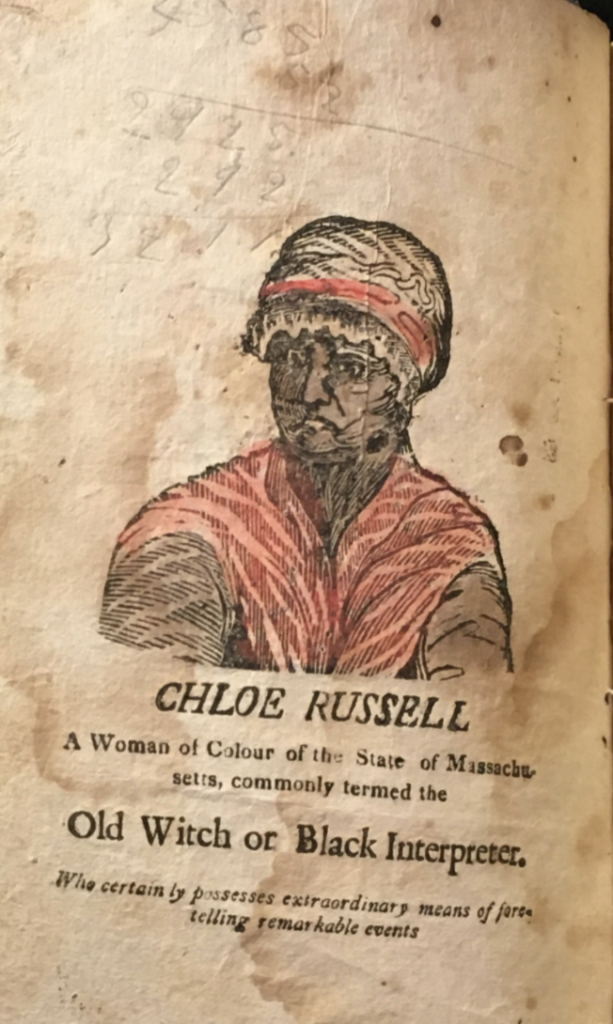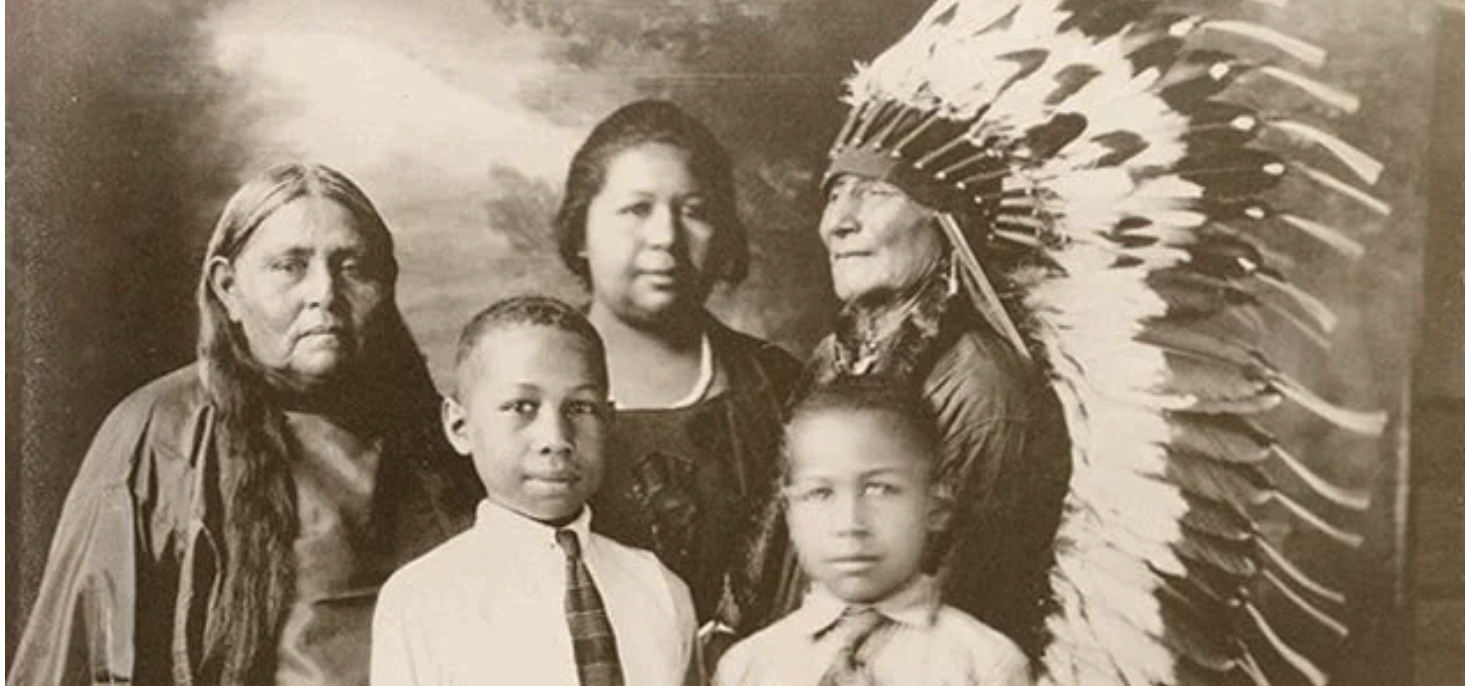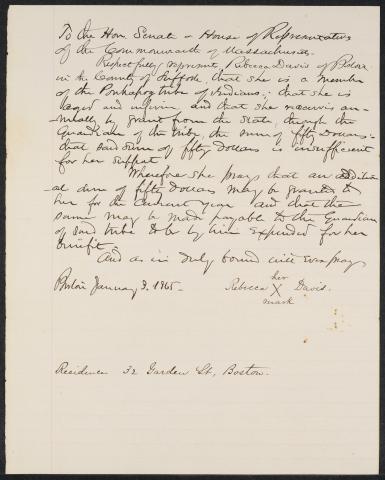Created by Stephen Kim & Savita Maharaj
Introduction
The cultural landscape of New England in the 18th century could provide some context for the many uncertainties surrounding the identity of Chloe Russell and the authorship of The Complete Fortune Teller and Dream Book. One aspect of this landscape was the close exchange between African American and Native American people, which varied across different regions and tribes, the kinship in festivities, economic activity, and frequently, in the union of marriage. This environment of rich cultural exchange can be seen through shared elements of supernatural lore, including motifs that pop up in Russell’s text. Yet, it also contributed to shared racist stereotypes by white Americans – and ultimately, figures like Chloe Russell who used these stereotypes to their advantage.

Russell, Chloe, The Complete Fortune Teller, and Dream Book, 1824, Boston Athenaeum. Book.
Marriage, Mixed Identities & Marginalization
In colonial New England, marriage between African Americans and Native Americans became common and oftentimes there were unions between Native American women and African American men. Gender discrepancies between both groups contributed to this trend. According to census records between 1765 and 1774, there were approximately fifty percent more Indian women than men, who left to join militias and whaling expeditions.1 Black men outnumbered black women by roughly the same percentage. The legal definition of matrilineal slavery meant that children born to native women and enslaved Black men would be born free. Intermarriage increased as enslavement in New England declined.2

DeVenney, Sam, “Comanche Family,” 1900s, Smithsonian Magazine, Photograph.
By the 18th and 19th centuries, Anglo-Americans were recording mythologized stories of the “last Indians remaining” in their villages.3 These tales were often exaggerated, and inaccurate; they tended to discount people of mixed heritage as “pure” native. When it came to racial characterization by white record-keepers, indigenous ancestry was often overshadowed by apparent skin color evident from public records and censuses. Individuals of both Native and African American descent were much more likely to be identified as “people of color,” “black,” “negro” or “mulatto” rather than Indian.4 People of mixed ancestry still maintained connections to their tribes, they likely may have gravitated towards African American culture because of the community it provided through urban institutions such as the First Church of Boston.5 Despite their invisibility in records, there was likely a larger presence of Native Americans in the 18th and 19th centuries than previously recorded or acknowledged.6
Native American Witchcraft
Anglo-American settlers aimed to spread widespread conversion to the indigenous population living there. Yet many Native Americans retained elements of their culture and beliefs. For example, in the Wampanoag tribe, Algonquian shamans performed healing rituals and used herbal remedies.7 Some “medicine men” and healers capitalized off their practice.8 There was a fluid exchange of these supernatural beliefs and motifs between Anglo-American, Native American and African American communities. Some black healers claimed to have learned some of their sorcery from Indian shamans – one such healer was Harriet Collins from Texas, who said, “My mammy learned me lots of doctorin’, she claimed, “what she learnt from old folkses in Africa, and some de Indians learned her.”9

“Petition of Rebecca Davis to the Massachusetts General Court,” 1865, Massachusetts Archives, Document.
There were a few instances of Native American female healers who, similarly to Russell, were able to gain some profit from their occult status. One healer, Rebecca Davis of the Punkapoag tribe, moved to Boston and sold an herb salve.10 Deloraine Coreywrote of two other women of native and possibly African descent who were mythologized in local lore [could insert name of book]. These women, known as Deb Saco and Hannah Shiner, were drifters who lived in the margins of society, yet were able to make money by selling wares and herbs.11 They are described in more detail to the right.
Native American female healers
Deb Saco (circa 1759-1839)
Deloraine Pendre Corey of Malden wrote, “Whether she was a negro or an Indian, I cannot say. Those who remember her are divided as to that matter . . . she was popularly supposed to be one hundred years old…A representation of her as a fortune-teller was formerly in the East India Museum in Salem, and she has often appeared by proxy at ladies’ fairs. I suspect that she was of two races, having an Indian mother. … She was a tramp, or, in the speech of that day, a ‘walk-about,’ ranging the country from Salem to Cambridge. She would disappear for months, returning suddenly, as eager to tell fortunes, as dirty, and as fond of rum as ever.”12
Hannah Shiner (circa 1738-1820)
“Of a similar character was Hannah Shiner, known also as Squa Shiner, an older woman, in whose veins the Indian blood predominated, if it were not wholly pure. She was a small woman with a thin face, and she usually traveled, with a small dog, selling baskets and herbs. She, too, was known in all the neighboring towns; but her home was near a spring on the borders of Turkey Swamp in Middlesex Fells, where she lived with a kindred spirit known as Old Toney. She is said to have been ‘kind hearted, a faithful friend, a sharp enemy, a judge of herbs, a weaver of baskets, and a lover of rum.’”
Native American Lore, Blackness, & Chloe Russell
On Treasure
In her section on dream interpretation, Russell wrote,
“Treasure – should you find a treasure in your dream you will be exposed to the treachery of a person you confide in.”13
In Native American lore, treasure was similarly seen as "a threat and the devil's temptation."14 This was in direct contrast to other New England folklore, which prized magic treasure for its wealth and power.
On Black Witchcraft
Legends from the Gay Head tribe, also known as the Aquinnah, on Martha’s Vineyard collected in the early 20th century reveal conflicted attitudes about intermarriage.15 In these legends, women who associated with Black men were deemed connected to witchcraft and the occult, illustrating how stereotypes of association with the occult were not only projected onto Native Americans, but also projected onto Black people in the lore of certain tribes.
"There was another woman around here who had a black man to work for her. Every morning when he woke up he found that he was as tired as though he had been working hard all night. He tried every way to get rest, but in spite of it all, he couldn’t. Nobody knew what to make of it until one night some person saw that woman riding as though on horseback, at breakneck speed through the country. When the person looked closer he saw that she was riding on the back of the black man, and he was bridled and saddled like a saddle horse. That was how they found out that she was a witch." 16
"It seems that a hundred years or so ago the Indians were all straight haired, but a certain squaw got into bad company consorting much with witches and other adepts of black art. Her curiosity, however, finally led her too far, and there came a time when she saw more than her friends thought good, whereupon the witches clawed her hair over her eyes and snarled it all up, and ever after the race has been snarly haired." 17
On Finding Husbands
Russell's book includes text on "Directions to young ladies how to obtain husbands they most desire" which contains exactly that: very detailed instructions for rituals that young women must perform in order to wed the object of their desires. The capability of the supernatural to meddle in affairs of love could also be seen in some Native American tales collected by Simmons. Two Gay Head superstitions are recounted below.
“Girls would sometimes break an egg in water and put it in the sun and in time it would take the form of a certain object. If a ship, the girl’s future husband would be a sailor, if land objects, he would be a landsman.” 18
Endnotes
1 Mandell, Daniel R.. Tribe, Race, History: Native Americans in Southern New England, 1780-1880, (Johns Hopkins University Press, 2008) 43
2 Ibid 44
3 Mandell, Daniel R.. Tribe, Race, History: Native Americans in Southern New England, 1780-1880, (Johns Hopkins University Press, 2008) 187
4 Baron, Donna Keith, et al. “They Were Here All Along: The Native American Presence in Lower-Central New England in the Eighteenth and Nineteenth Centuries.” (JSTOR, 1996) 566
5 Mandell, Daniel R.. Tribe, Race, History: Native Americans in Southern New England, 1780-1880, (Johns Hopkins University Press, 2008) 68
6 Baron, Donna Keith, et al. “They Were Here All Along: The Native American Presence in Lower-Central New England in the Eighteenth and Nineteenth Centuries.” (JSTOR, 1996) 561–586
7 Winiarski, Douglas L. “Native American Popular Religion in New England’s Old Colony, 1670–1770.” (Religion and American Culture: A Journal of Interpretation, 2005) 164
8 Ibid; Mandell, Daniel R.. Tribe, Race, History: Native Americans in Southern New England, 1780-1880, (Johns Hopkins University Press, 2008) 32
9 Chireau, Yvonne P.. Black Magic:Religion and the African American Conjuring Tradition, (University of California Press, 2003) 56
10 Mandell, Daniel R.. Tribe, Race, History: Native Americans in Southern New England, 1780-1880, (Johns Hopkins University Press, 2008) 32
11 Corey, Deloraine P. (Deloraine Pendre), 1836-1910. The History of Malden, Massachusetts, 1633-1785 (1899) 413
12 Ibid
13 Russell, Chloe, The Complete Fortune Teller, and Dream Book, Boston Athenaeum (1824) 281
14 Mandell, Daniel R.. Tribe, Race, History: Native Americans in Southern New England, 1780-1880, (Johns Hopkins University Press, 2008) 109
15 Simmons, William Scranton. Spirit of the New England Tribes: Indian History and Folklore, 1620-1984. (University Press of New England, 1986) 99
16 Ibid
17 Simmons, William Scranton. Spirit of the New England Tribes: Indian History and Folklore, 1620-1984. (University Press of New England, 1986) 100
18 Simmons, William Scranton. Spirit of the New England Tribes: Indian History and Folklore, 1620-1984. (University Press of New England, 1986) 109
Bibliography
Baron, Donna Keith, et al. “They Were Here All Along: The Native American Presence in Lower-Central New England in the Eighteenth and Nineteenth Centuries.” The William and Mary Quarterly, vol. 53, no. 3, 1996, pp. 561–586. JSTOR, www.jstor.org/stable/2947204.
Chireau, Yvonne P.. Black Magic : Religion and the African American Conjuring Tradition, University of California Press, 2003. ProQuest Ebook Central, https://ebookcentral.proquest.com/lib/northeastern-ebooks/detail.action?docID=223936.
Clayton, Jay, and Joanna Brooks. American Lazarus : Religion and the Rise of African-American and Native American Literatures, Oxford University Press, Incorporated, 2003. ProQuest Ebook Central, https://ebookcentral.proquest.com/lib/northeastern-ebooks/detail.action?docID=279710.
Corey, Deloraine P. (Deloraine Pendre), 1836-1910. The History of Malden, Massachusetts, 1633-1785. Malden, 1899.
DeVenney, Sam.“Comanche Family. ” Smithsonian Magazine, 1900s. Photograph. https://www.smithsonianmag.com/history/an-ancestry-of-african-native-americans-7986049/
Ehninger, John W. "Giles Corey of Salem Farms," 1880. The Poetical Works of Longfellow. Houghton Mifflin Boston, 1880, p. 723.
Mandell, Daniel R.. Tribe, Race, History : Native Americans in Southern New England, 1780-1880, Johns Hopkins University Press, 2008. ProQuest Ebook Central, https://ebookcentral.proquest.com/lib/northeastern-ebooks/detail.action?docID=4398356.
“Petition of Rebecca Davis to the Massachusetts General Court,”Massachusetts Archives,1865, Document. http://nativenortheastportal.com/digital-heritage/petition-rebecca-davis-massachusetts-general-court-4
Simmons, William Scranton. Spirit of the New England Tribes: Indian History and Folklore, 1620-1984. E-book, Hanover: University Press of New England, 1986, https://hdl-handle-net.ezproxy.neu.edu/2027/heb.03827.
Winiarski, Douglas L. “Native American Popular Religion in New England’s Old Colony, 1670–1770.” Religion and American Culture: A Journal of Interpretation, vol. 15, no. 2, 2005, pp. 147–186., doi:10.1525/rac.2005.15.2.147.
Russel, Chloe. The Complete Fortune Teller and Dream Book. 1827, Boston Atheneaum.
